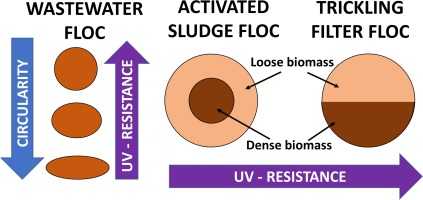当前位置:
X-MOL 学术
›
Water Res.
›
论文详情
Our official English website, www.x-mol.net, welcomes your feedback! (Note: you will need to create a separate account there.)
The Tail of Two Models: Impact of Circularity and Biomass Non-Homogeneity on UV Disinfection of Wastewater Flocs
Water Research ( IF 12.8 ) Pub Date : 2017-09-06 , DOI: 10.1016/j.watres.2017.09.011 Y. Azimi , Y. Liu , T.C. Tan , D.G. Allen , R.R. Farnood
Water Research ( IF 12.8 ) Pub Date : 2017-09-06 , DOI: 10.1016/j.watres.2017.09.011 Y. Azimi , Y. Liu , T.C. Tan , D.G. Allen , R.R. Farnood

|
The effects of floc structural characteristics, i.e. shape and dense biomass distribution, were evaluated on ultraviolet (UV) disinfection resistance, represented by the tailing level of the UV dose response curve (DRC). Ellipsoid-shaped flocs of similar volume and different projected circularities were constructed in-silico and a mathematical model was developed to compare their UV DRC tailing levels (indicative of UV-resistance). It was found that floc shape can significantly influence tailing level, and rounder flocs (i.e. flocs with higher circularity) were more UV-resistant. This result was confirmed experimentally by obtaining UV DRCs of two 75‒90 μm floc populations with different percentages (20% vs. 30%) of flocs with circularities higher than 0.5. The population enriched in less circular flocs (i.e. 20% flocs with circularities > 0.5) had a lower tailing level (at least by 1-log) compared to the other population. The second model was developed to describe variations in UV disinfection kinetics observed in flocs with transverse vs. radial biomass non-homogeneity, indicative of biofilm-originated vs. suspended flocs. The varied-density hemispheres model and shell-core model were developed to simulate transverse and radial non-homogeneity, respectively. The UV DRCs were mathematically constructed and biofilm-originated flocs showed higher UV resistance compared to suspended flocs. The calculated UV DRCs agreed well with the experimental data collected from activated sludge and trickling filter flocs (no fitting parameters were used). These findings provide useful information in terms of designing/modifying upstream processes for reducing UV disinfection energy demand.
中文翻译:

两种模式的尾巴:循环度和生物量非均质性对废水絮凝体紫外线消毒的影响
评估了絮体结构特征(即形状和密集的生物量分布)对紫外线(UV)消毒抗性的影响,用紫外线剂量响应曲线(DRC)的拖尾水平表示。在硅胶内构建类似体积和不同投影圆度的椭球形絮状物建立了一个数学模型来比较它们的UV DRC拖尾水平(指示抗紫外线性)。发现絮状物的形状可以显着影响尾矿含量,并且较圆的絮状物(即具有较高圆形度的絮状物)更耐紫外线。通过获得两个75×90μm絮凝物种群的UV DRC,具有不同的絮凝物百分比(20%对30%),圆度高于0.5,通过实验证实了这一结果。与其他种群相比,富含较少圆形絮凝物(即20%的圆形度> 0.5的絮凝物)的种群的尾矿水平较低(至少按1-log计)。开发了第二个模型,以描述在具有横向和径向生物质不均一性的絮凝物中观察到的紫外线消毒动力学变化,这表明起源于生物膜的絮凝与悬浮的絮凝物。建立了变密度半球模型和壳核模型,分别模拟了横向和径向非均匀性。UV DRC是通过数学方式构建的,与悬浮的絮凝物相比,生物膜起源的絮凝物显示出更高的抗紫外线性。计算得出的UV DRC与从活性污泥和滴滤滤池絮凝物收集的实验数据非常吻合(未使用拟合参数)。这些发现为减少紫外线消毒能量需求的上游工艺的设计/修改提供了有用的信息。计算得出的UV DRC与从活性污泥和滴滤滤池絮凝物收集的实验数据非常吻合(未使用拟合参数)。这些发现为减少紫外线消毒能量需求的上游工艺的设计/修改提供了有用的信息。计算得出的UV DRC与从活性污泥和滴滤滤池絮凝物收集的实验数据非常吻合(未使用拟合参数)。这些发现为减少紫外线消毒能量需求的上游工艺的设计/修改提供了有用的信息。
更新日期:2017-09-06
中文翻译:

两种模式的尾巴:循环度和生物量非均质性对废水絮凝体紫外线消毒的影响
评估了絮体结构特征(即形状和密集的生物量分布)对紫外线(UV)消毒抗性的影响,用紫外线剂量响应曲线(DRC)的拖尾水平表示。在硅胶内构建类似体积和不同投影圆度的椭球形絮状物建立了一个数学模型来比较它们的UV DRC拖尾水平(指示抗紫外线性)。发现絮状物的形状可以显着影响尾矿含量,并且较圆的絮状物(即具有较高圆形度的絮状物)更耐紫外线。通过获得两个75×90μm絮凝物种群的UV DRC,具有不同的絮凝物百分比(20%对30%),圆度高于0.5,通过实验证实了这一结果。与其他种群相比,富含较少圆形絮凝物(即20%的圆形度> 0.5的絮凝物)的种群的尾矿水平较低(至少按1-log计)。开发了第二个模型,以描述在具有横向和径向生物质不均一性的絮凝物中观察到的紫外线消毒动力学变化,这表明起源于生物膜的絮凝与悬浮的絮凝物。建立了变密度半球模型和壳核模型,分别模拟了横向和径向非均匀性。UV DRC是通过数学方式构建的,与悬浮的絮凝物相比,生物膜起源的絮凝物显示出更高的抗紫外线性。计算得出的UV DRC与从活性污泥和滴滤滤池絮凝物收集的实验数据非常吻合(未使用拟合参数)。这些发现为减少紫外线消毒能量需求的上游工艺的设计/修改提供了有用的信息。计算得出的UV DRC与从活性污泥和滴滤滤池絮凝物收集的实验数据非常吻合(未使用拟合参数)。这些发现为减少紫外线消毒能量需求的上游工艺的设计/修改提供了有用的信息。计算得出的UV DRC与从活性污泥和滴滤滤池絮凝物收集的实验数据非常吻合(未使用拟合参数)。这些发现为减少紫外线消毒能量需求的上游工艺的设计/修改提供了有用的信息。



























 京公网安备 11010802027423号
京公网安备 11010802027423号